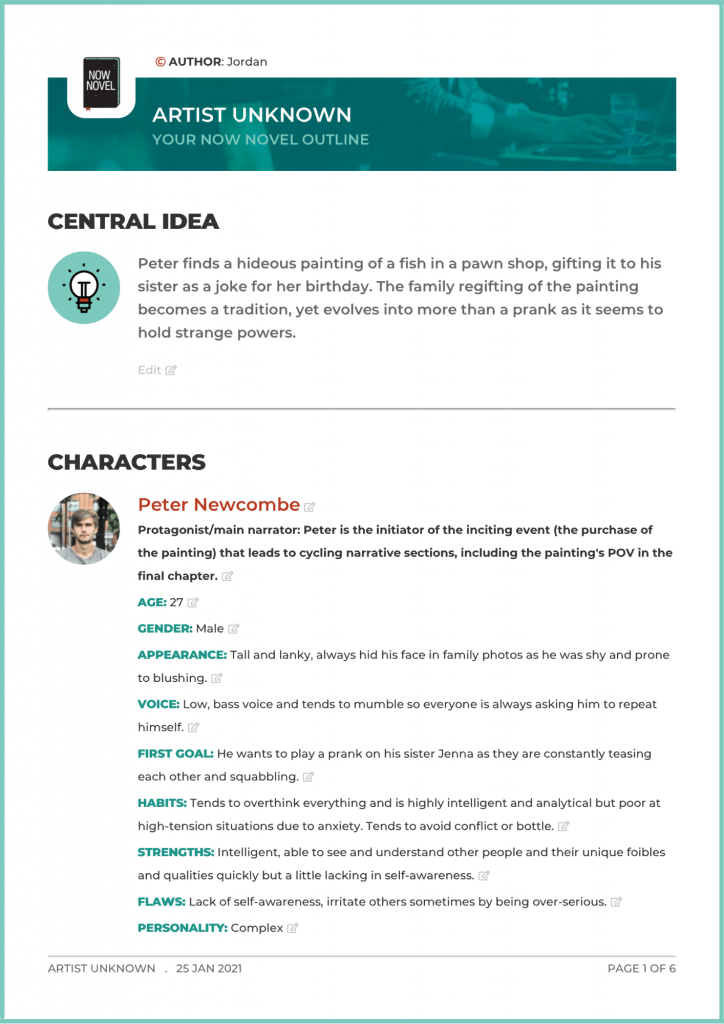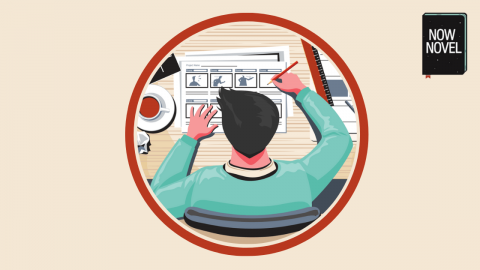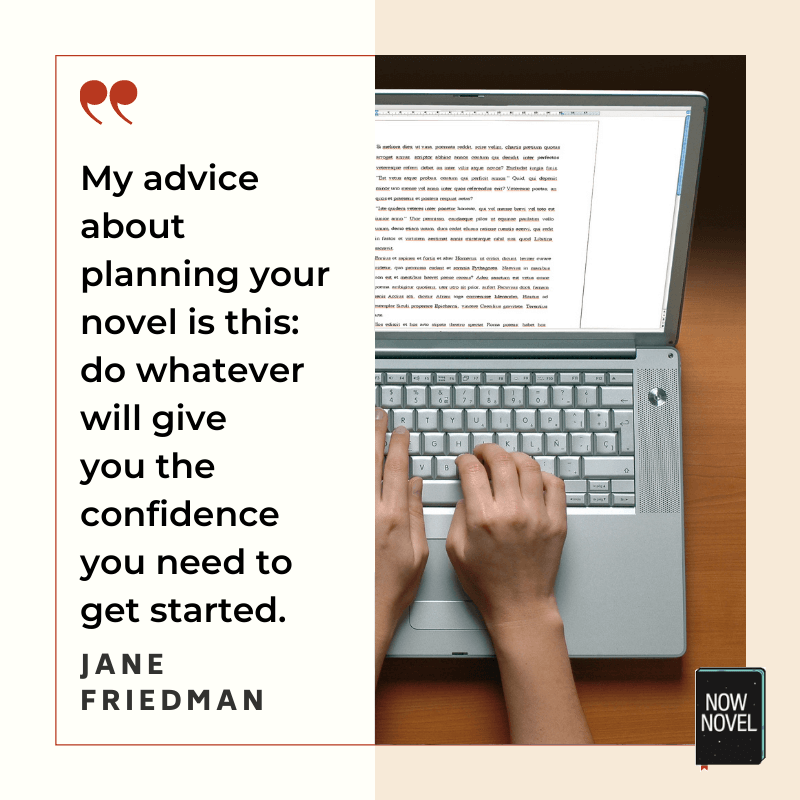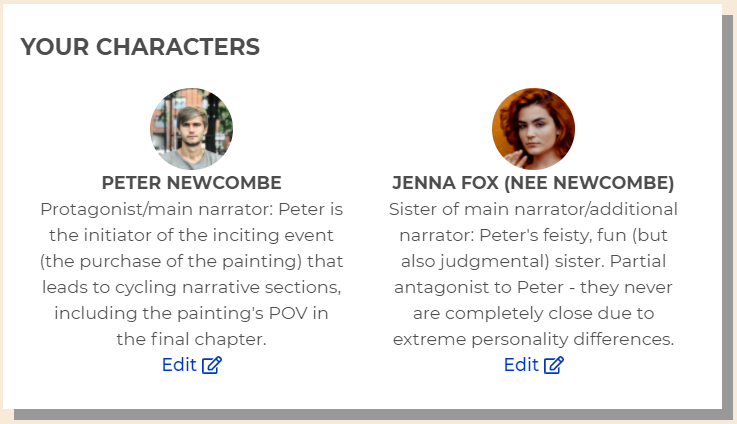Deciding how to outline a novel (or whether to outline at all) is a personal process for each author. This sample book outline plus 7 checks and insights will help you outline with purpose:
Novel outlining: Pros, Cons, and Pitfalls
Outlining novels: Pros and cons
Should I outline a novel?
‘Pantsing’ pitfalls
Sample Novel Outline
How to outline a novel while avoiding cons:
1. Have a broad yet specific story idea
2. Have core ideas of characters to expand
3. Know crucial details of plot
4. Research or understand your novel’s setting
5. Have an idea of who will narrate
6. Keep asking interesting questions
7. Alternate planning with drafting
Outlining novels: Pros and cons
Before we examine a sample book outline and discuss it in detail, let’s examine what authors and editors say about the value of outlining.
Some authors (Stephen King among them) profess to be ‘pantsers’ (referring to writing ‘by the seat of your pants’).
In his writing manual On Writing, King compares writing to excavating around a fossil (the hard kernel of an idea) to discover more of its story.
Says King:
I won’t try to convince you that I’ve never plotted any more than I’d try to convince you that I’ve never told a lie, but I do both as infrequently as possible. I distrust plot for two reasons: first, because our lives are largely plotless, even when you add in all our reasonable precautions and careful planning; and second, because I believe plotting and the spontaneity of real creation aren’t compatible.
Stephen King, On Writing (2000), p. 163.
The idea that a story outline could be restrictive is plausible (though it’s unclear why – to King – planning is not an act of ‘real creation’).
Editor and publishing strategist Jane Friedman gives a less absolute view on whether or not to outline a novel before drafting:
My advice about planning your novel is this: do whatever will give you the confidence you need to get started. If diving right in works for you, that’s awesome. If you need an elaborate outline, write an elaborate outline.
Jane Friedman, ‘To Outline or Not to Outline your Novel’.
Key points ‘for’ and ‘against’ outlining books:
Should I outline a novel?
Pros of outlining:
- Helps you get started
- Fosters confidence in your writing process and progress
- Guides expansive elaboration
Cons of creating an outline:
- May decrease spontaneity
- Involves plotting which isn’t how ‘real’ life unfolds (sometimes without linear direction or obvious meaning), according to Stephen King
- Potentially limits a process of discovery (according to NY Book Editors)
It is wonderful when we have a rush of spontaneous ideas and write as though in a fever dream.
Creating this way doesn’t work for everyone, though, the same way a fixed approach to outlining doesn’t work for everyone. This is why we made our story outlining tools more flexible, to suit the many different starting points of writing a novel.
‘Pantsing’ pitfalls
Spontaneous creativity, what King calls ‘real creation’, may lead to its own issues, such as:
- Lack of cohesion (fragments created in flashes of inspiration failing to weave together in a coherent story)
- Writer’s block: What happens when the muse doesn’t come when bidden, spontaneity evaporates or ideas for what comes next dry up?
How to outline a novel (and avoid King’s cons)
See this novel outline template, then read 7 checks for how to outline without losing spontaneity or creativity:
Sample book outline
In deciding how to outline a novel, there are many categories of information you could include, in varying degrees of detail.
To begin, your central idea or story premise, which you can see in the sample book outline page below, along with simple ideas for character details:

Here’s how to outline a novel with confidence. To become a better book writer, check that you:
1. Have a broad yet specific story idea
Find a story premise or idea you’re excited to explore further. It could be:
- An idea combining three topics you find interesting (for the above sample book outline, the topics were ‘art’, ‘tradition’ and ‘family relationships’)
- An anecdote someone once told you about an interesting event or act that you transform into your own fiction
- A ‘high concept’ (for example, ‘what if a new planet were discovered where there were abundant resources and there was a global race to claim/colonize it?’)
Look again at the sample story idea in the novel outline above:
Peter finds a hideous painting of a fish in a pawn shop, gifting it to his sister as a joke for her birthday. The family regifting of the painting becomes a tradition, yet evolves into more than a prank as it seems to hold strange powers.
It is:
- Specific: Particular people, events, actions and/or settings are implied
- Broad or expansive: It leaves room to explore and imagine the different family members, the way the gift of the painting transforms and changes (what role the painting plays, what the ‘strange powers’ hinted at are)
- Full of implied change: Change is the lifeblood of stories. The impact of a small act changes (the painting becoming more central to the family’s lives and traditions). The original intent of Peter’s gesture (a prank) could spin out in all kinds of directions
Find your central idea
Brainstorm a central idea, build character profiles and more using easy writing tools.
LEARN MORE
2. Have core ideas of characters to expand
By Stephen King’s definition, ‘plotting’ (making choices about what will happen in a story before writing the scene itself) stifles spontaneity.
When you brainstorm characters, however, there is spontaneity in this process itself. You pull phrases out of thin air, as you do when writing a scene. Writing novel ideas for characters gets creativity flowing.
In learning how to outline a novel, it’s important to remember that all these decisions are also provisional, open to change.
You can add in character ideas or take them out. Casually add in new scene outlines and chapter summaries, too (remember to update your outline afterwards, to keep the ‘bird’s eye view’ of your growing story up-to-date).
The character overview summary of Peter Newcombe (the protagonist for the sample book outline above) and his sister, Jenna:
Because our central idea was broad yet specific (mentioning a male protagonist and his sister), these are two characters we have plenty of room to expand upon.
This makes it easier to have spontaneous fun creating, finding conflicts, happier scenes and other moments within the parameters we’ve set.
3. Know crucial details of plot
Stephen King and many others may balk at plotting a novel outline in advance.
An outline is not every bend in the road, every footprint captured in poured, set concrete. The drafting process is often like the ducks that walk over said concrete. Chaotic. Surprising. Often, infuriating.
Learning how to outline a novel so that this process is less chaotic does not necessarily stop the good kind of surprise.
Within broad yet specific parameters, there are still many ways things could go. Ways the story could begin (or end).
Find key details of plot (plot points) that are already decided to expand upon.
For the sample book outline above, we know:
- A brother plays a prank on his sister
- Their family incorporates said prank (the gifting of an ugly painting for a birthday) into their traditions
Within these two ideas or plot points, there are many questions to ask; scenes to imagine.
You might make a list of possible scene ideas like this:
- Peter finds a painting in local pawn shop ‘Tat for Tits’
- He haggles with the shopkeeper who tries to pretend the painting is by Renoir (it definitely isn’t)
- He tries to disguise the painting when he wraps it so his sister will have no idea what it is
4. Research or understand your novel’s setting
In discussions about how to outline a novel, there’s often an extreme focus on plot.
The truth is every element of a story – plot, character, place, structure – is something you may explore a little before you’ve written the first line of your story. They’re all intertwined, too.
Knowing your story’s setting, its ‘where’ and ‘when’, is helpful.
If Peter and Jenna in our sample book outline are living in 1940s Boston, Massachussets, for example, this will yield a very different field of plot (or story) constraints and possibilities than if they’re living in 1980s Durban, South Africa.
If you were setting your story in 1940s Boston, for example, there would be local events to add to your outline.
For example, you might note that the Cocoanut Grove Fire (the deadliest nightclub fire, claiming 492 lives) happened in 1942.
Understanding key historical moments (whether your story is set in our ‘real’ world or an invented one) will help you think further about the external forces that shape people’s experiences and perceptions.
5. Have an idea of who will narrate
When you outline a novel, think about who is going to tell the story.
As you can see in the character overview summaries from the Now Novel dashboard above, there are notes on the story having at least three planned narrators:
- The story’s protagonist, Peter
- His spicier sister, Jenna
- An unusual narrator – the painting that is the object underlying the inciting incident, which, in this outline example will share it’s own strange perspective as a sort of closing or epilogue to the story
Write down who you’d like to make the main narrator of your story.
List reasons why they’d make a good narrator. For the painting, for example, you could say:
- It’s an unexpected narrator, which will add an element of surprise/mystery
- Hanging in the different family members’ homes will give it private insights the main narrators don’t necessarily have about each others’ lives and secrets
6. Keep asking interesting questions
As you continue to outline your novel, keep asking interesting questions. Note your ideas.
For example, in the process of writing this, the haggling pawn shop owner who argues his rubbish paintings are actually Renoir originals came to mind. Why?
Because the question came up: ‘What happens in the scene where Peter finds the painting?’ Or, ‘How does Peter find and acquire the painting?’
Once you’ve learned how to outline a novel, it’s easier to know what questions to ask to find fun new characters and situations quickly.
This is easier than grasping at patchy ideas when you’re in the middle of a ‘spontaneous’ scene.
7. Alternate planning with drafting
Returning to Stephen King and NY Editors’ objections to outlining, how do you avoid stifling spontaneity and avoid what NY Editors call a book ‘dead on arrival’?
The answer is simple: Adapt outlining to your needs and the degree of detail and structure you need to get going.
A central idea and a character profile or two may be enough. Or you may want to draft a scene or two, then dive back into profiling a new character so that you can picture them clearly during their first introduction.
Learn how to outline a novel in easy, prompted steps and discover why Now Novel is frequently reviewed as a five-star novel planning website.




